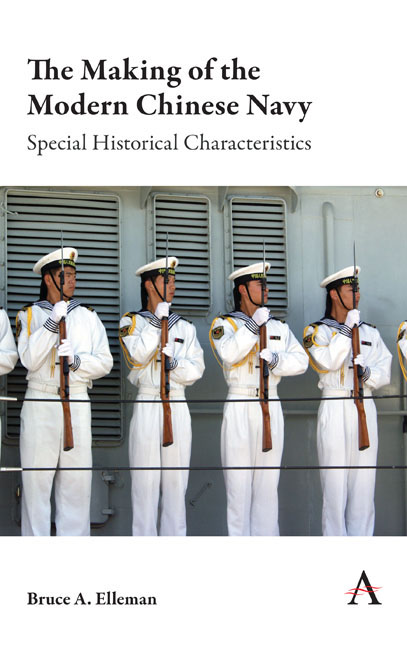Book contents
- Frontmatter
- Contents
- Introduction: The Special Characteristics of China's Maritime History
- 1 Battle of Bạch Đăng River (938)
- 2 Battle of Yaishan (1279)
- 3 Battle of Lake Poyang (1363)
- 4 Ming–Kotte War in Southeast Asia (1410–11)
- 5 Ming Loyalists Flee to Taiwan (1661–83)
- 6 Battle of Chuanbi (1839)
- 7 Sino-French War (1884–85)
- 8 Qing Beiyang Fleet's Defeat in the Battle of the Yellow Sea (1894)
- 9 Chinese Decision to Sink The Nationalist Navy as Blockships (1937)
- 10 Chongqing Mutiny Allowing the PLA to Cross the Yangzi River (1949)
- 11 The Taiwan Strait Crises (1954–55 and 1958)
- 12 China's Decision to Take the Paracel Islands from South Vietnam (1974)
- 13 Missile Blockade: The Taiwan Strait Crisis (1995–96)
- 14 The EP-3 Standoff and Diplomatic Resolution (2001)
- Conclusions: The Influence of History on the Formation of a Modern Chinese Navy
- Selected Bibliography
- Index
1 - Battle of Bạch Đăng River (938)
Published online by Cambridge University Press: 04 October 2019
- Frontmatter
- Contents
- Introduction: The Special Characteristics of China's Maritime History
- 1 Battle of Bạch Đăng River (938)
- 2 Battle of Yaishan (1279)
- 3 Battle of Lake Poyang (1363)
- 4 Ming–Kotte War in Southeast Asia (1410–11)
- 5 Ming Loyalists Flee to Taiwan (1661–83)
- 6 Battle of Chuanbi (1839)
- 7 Sino-French War (1884–85)
- 8 Qing Beiyang Fleet's Defeat in the Battle of the Yellow Sea (1894)
- 9 Chinese Decision to Sink The Nationalist Navy as Blockships (1937)
- 10 Chongqing Mutiny Allowing the PLA to Cross the Yangzi River (1949)
- 11 The Taiwan Strait Crises (1954–55 and 1958)
- 12 China's Decision to Take the Paracel Islands from South Vietnam (1974)
- 13 Missile Blockade: The Taiwan Strait Crisis (1995–96)
- 14 The EP-3 Standoff and Diplomatic Resolution (2001)
- Conclusions: The Influence of History on the Formation of a Modern Chinese Navy
- Selected Bibliography
- Index
Summary
Chinese views on gaining and losing “face” can play an important role in warfare. In 938, the Vietnamese opposed a fleet sent by the invading southern Han Chinese state called Nan-Han. Ngô Quyên ordered iron-headed poles to be placed under the waters of the Bạch Đăng River, and he then lured the Chinese fleet upriver during high tide. When the tide receded, the enemy's ships were pushed downstream by the strong current and impaled on the poles. Three hundred and fifty years later, in 1288, a Mongol fleet was defeated in exactly the same way in the same place. This suggests that the Han Chinese naval officers did not tell their Mongol commanders about the earlier defeat, either because they did not know about it themselves or, more damning, perhaps considered it a “loss of face” to admit to the Mongols this earlier defeat at the hands of their former tributary, Vietnam.
Summary of the Bạch Đăng River Battle
Sunzi's Art of War does not include a single word about sea battles. What he does mention is the importance of currents and, in particular, river currents. Maritime warfare in ancient China was conducted mainly on canals, rivers, and inland lakes, not on the open ocean. River battles could make or break Chinese dynasties. For example, the 663 victory at the mouth of the Paek River was widely considered to be the height of the Tang dynasty's naval activities. Similarly, the 938 defeat at Bạch Đăng River would be the low point of the successor Nan-Han state.
By the eighth and ninth centuries, there was a gradual slowdown of the Tang expansion and a withdrawal from China's far-flung military outposts. Constant wars against the Turks, the Uighurs, the Tibetans, and Arabs in the West drained China's finances. Rebellions meant that large sections of the Tang empire became semi-independent from the capital's control. Finally, in 906, the Tang dynasty fell. China was subdivided into a number of small states, each seeking to dominate the others. While the northern states relied mainly on their large armies, the southern coastal states were maritime powers. This created a military stalemate that lasted for several decades. Nan-Han was one such maritime state, located in modern-day Guangdong province. It became rich through maritime commerce, which allowed it to support a strong navy.
- Type
- Chapter
- Information
- The Making of the Modern Chinese NavySpecial Historical Characteristics, pp. 7 - 10Publisher: Anthem PressPrint publication year: 2019



